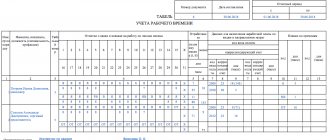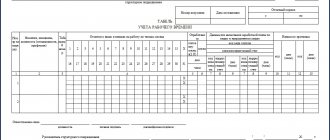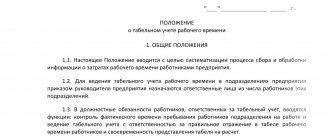The modern pace of business development forces us to constantly monitor the productivity growth of both startup owners and CEOs of world-famous corporations. New approaches to doing business are being developed, the demands of employers in the labor market are growing, specialists are invited to evaluate the performance of employees - and all these measures are taken to ensure that the company grows in the eyes of consumers and clients, receives profit and resources for further development.
With a reasonable approach, creative methods really work, but do not forget about the classic aspects: for example, identifying irresponsible and, on the contrary, diligent employees.
The employer is helped in this mission by nothing more than a time log. This document is intended to indicate the time that the employee actually worked, and also records the employee’s arrival and departure from the workplace, notes information about tardiness, absenteeism and delays. Despite such extensive functionality, the journal for recording the arrival and departure of employees turns out to be useful in many other cases, the main thing is to know how it should be maintained and ensure that it is filled out in a timely manner. Let's look at all the details of this issue in the following article.
Why do you need a document?
Before answering this question, let us dwell in more detail on the actual concept of “working time”. As you know, a standard work week lasts 40 hours – 8 hours a day. During this period, the employee must perform the labor functions assigned to him by the employer in full accordance with the labor (or collective) agreement and regulations adopted at the enterprise.
Wages are calculated based on hours worked. All hours that the employee spent at work in excess of this legally established norm are paid at a double rate. But if an employee does not work enough time, management has the right to apply certain sanctions to him.
To resolve issues related to the establishment of actually worked hours, a working time log is being developed.
Information in the journal is entered for each employee of the organization separately.
Thus, the document is necessary for both parties to the labor relationship, since it performs several functions at once:
- Solves the problem of monitoring the time that each employee of the enterprise spends at his workplace.
- Serves as the basis for calculating wages (especially if the organization accepts hourly wages).
- It is an aid to management in the matter of organizing discipline at the enterprise.
Sometimes a document can become a substantiating reason for imposing a disciplinary sanction on an employee who has violated work regulations.
What it is
The journal is not a standardized document and does not have a single approved form. The most common templates can be found online or purchased at a stationery store. An enterprise can develop and approve its own journal form.
To determine the time worked by an employee, you will need the following information:
- employee data that allows him to be uniquely identified (full name, position, structural unit);
- information about the beginning and end of the working day, confirmed by the personal signature of the employee and the controller;
- information about absence from the workplace, indicating the reason, with the signature of the employee or responsible person (for example, about being sent on a local business trip);
- notes on business trips, time off, agreed upon postponements of the start of the working day and other agreements between the employer and employee.
The journal can be kept in a notebook or formed by filling out daily accounting sheets that are filed or stapled. Individual sheets must have the necessary protection against forgery (date, stamp and signature of the responsible person).
How to count working hours
There are several methods for recording working hours:
- Standard daily - used if employees come to and leave work at the same time.
- With weekly accounting, the daily parameter loses its significance, since employees are not required to “sit out” hours, but must fulfill a certain work rate during the week, including time (for example, on one day an employee works six hours, on another - ten).
- The summarized method is optimal in production or with a flexible work schedule. Typically, data is recorded here based on the results of the month, but sometimes longer periods are also covered (the maximum is one year).
Is it necessary
The Labor Code (Article 91) requires the employer to keep records of working hours. Controlling work time has two main goals:
- prevention of exceeding established work time limits, including during irregular working hours;
- identifying cases of violation of labor discipline.
The Code does not oblige the enterprise to keep a logbook. To calculate wages, a time sheet is required, which is drawn up on the basis of a journal, administrative documents and employee explanations.
In accordance with the Law “On Archival Affairs,” the Ministry of Culture indirectly established the need to maintain an accounting journal - through approving the storage periods for a standard archival document generated as a result of the activities of government agencies, local governments and organizations.
This provision was recognized by the Supreme Arbitration Court as not contradicting the current legislation regarding the obligation of commercial organizations to store the listed documents, including time sheets and logs of hours worked (decision of the Supreme Arbitration Court 14589/11 of 02.21.12).
How to Journal
The journal can be kept in electronic and paper form.
Electronic journaling is possible in different formats, depending on what software the employer uses. There are budget forms, in which almost all actions are carried out manually, and there are more complex, “advanced”, fully automated systems that transfer information directly to accounting programs (usually access to such software occurs only if the employee has a key).
In any case, the electronic form of the document is convenient, because allows you to save time, effort and makes it possible to easily control the working time of employees based on indicators such as unauthorized absences, overtime, sick leave, etc.
If the journal is kept in paper form, then all its sheets must be numbered, fastened together using a “harsh” thread (a stapler cannot be used), then the number of sheets must be marked on the last page, stamped (provided that the seal is used in the work of the organization) and sign the employee responsible for maintaining the journal. In the future, you should autograph each completed page of the document.
The journal is usually kept by a human resources specialist or an accounting employee. Depending on this, the storage location of the document during its validity period is determined.
The responsible employee is responsible not only for the accuracy of the information entered in the journal, but also for its timely and complete transfer to specialists for payroll, as well as for performing all other necessary actions.
Magazine form
Each organization can approve its own ledger format for recording arrivals and departures from work. Mandatory journal details:
- full name of the organization, including legal form;
- start and end dates of maintenance (filled in upon actual);
- data of the responsible person;
- number of pages filed.
All pages inside the book must be numbered, and the cover must indicate the total number of pages.
You can download the excel form.
Columns that can be included in the journal for each working day:
- FULL NAME.;
- department, position;
- time of arrival at work, signatures of the employee and the controller;
- time of leaving work, signatures of the employee and the controller;
- comments about the reasons for lateness and absence;
- service columns used to fill out the timesheet (number of hours worked, etc.).
The person responsible for maintaining the log is required to ensure that the employee is identified using a regular or electronic pass or identification document.
The responsibility for keeping a log should be assigned to an employee (for example, a security guard or watchman) by order of the organization. For each month, one journal is created for the entire organization or its structural unit.
Sample employee time log
If you need to create an employee time log, use the tips below and see a sample document.
The magazine does not have a uniform design standard. This means that representatives of each organization can form it in any form or according to a template developed within the company and approved by management, as well as the trade union body (if there is one).
Like the design of the magazine, its structure and text are completely left to the employees of the enterprise.
It is recommended to write on the title page:
- Company name;
- journal opening date and end date (entered after the document is closed);
- indicate the employee responsible for its maintenance;
- if the organization has a list of cases, then you need to provide a link to the journal index in accordance with this accounting document.
The main part of the journal is best presented in the form of a table in which the following data must be entered:
- serial number of the employee, his full name and position;
- date, time of arrival and departure, as well as information about lateness (the exact number in minutes and hours);
- information about absenteeism - yes/no;
- the amount of total time worked (minus absences on personal business);
- employee signature.
If required, the table can be supplemented with other data (for example, about why the employee left the workplace during the day).
Legislative framework and purposes of recording time worked
Compliance with the Labor Code of the Russian Federation prevents controversial situations surrounding working hours as much as possible.
The time during which an employee must perform work duties as regulated by the employment contract and internal regulations is called working time. Organizations are required to keep records of the hours each employee actually works.
The law protects both parties to an employment contract.
From the employee's point of view, management does not have the right to force employees to work hours beyond the state limit. A normal working week should not exceed 40 hours. Overtime work also has a limit - no more than 4 hours for two days in a row and 120 hours per year.
An advantage for the employer is the ability to control business trips, lateness, absenteeism, sick leave, and vacations of subordinates. This data is used both to reward hardworking employees and to take disciplinary action against violators.
! Do not forget that, according to Article 81 of the Labor Code of the Russian Federation, an employer can, on his own initiative, terminate an employment contract with an employee if the latter is absent from the workplace for the entire working day (shift) without good reason, i.e. for absenteeism.
With hourly wage rates, control of working hours is necessary for both parties.
How are papers destroyed?
Their destruction is considered a simple process, and all documents whose shelf life expires are written off from the beginning of the next year. But for this to happen, an audit must already be carried out.
Important! If papers are removed from the state archive, then a special invoice is drawn up for this.
All acts subject to destruction are described in a special list presented in the write-off act. It indicates all the papers that will be destroyed, their quantity and numbers. Here you will learn how to write off accounts payable with an expired statute of limitations.
All files that are planned to be written off must be kept separately from other papers. The act made is initially approved by the head of the company, for which a commission gathers and considers the issue.
The fact of destruction is confirmed by an act of destruction of documents, and often the documents are burned or special devices are used. The procedure is carried out in the presence of commission members, who then certify the process with their signatures.
Important! Often at one enterprise it is necessary to destroy a lot of papers, and in this case you can hand them over to special companies specializing in this process.
How to draw up a write-off act
It does not need to describe each case in detail, so only information is entered into it:
- name of the documents, for example, order or certificate;
- the dates when they were created are indicated;
- case number according to the inventory;
- shelf life;
- article number, for which you need to focus on the above List.
At the end of the document, it is certainly written down how many files are destroyed, and the document is also signed by a commission, which must consist of three or more people. The signature of the head of the company is placed at the top.
A sample of filling out an act on the allocation for destruction of documents that are not subject to storage.
Order
An internal document of the organization (order) establishes the responsibility of employees for entering correct information into the working time log, as well as the responsibilities of the controller for checking the information and confirming it.
The form of the journal can be approved either together with the responsibilities for filling it out, or as a separate document.
Working hours for 2021: main differences from 2021
The working time schedule for 2021 is a multi-component document informing about the following:
- standard working hours;
- number of weekends and working days;
- boundaries and duration of the working day;
- combination of working periods with rest periods.
IMPORTANT! In 2021, those working the usual five-day workday will need to work 247 working days out of 365 calendar days. In 2020 there were 248 out of 366.
Comparing the annual chart of the period under review with the previous one, we can note the following:
- in 2021, the number of working and calendar days is 1 less, because the previous year was a leap year;
- Of the working days specified in the first paragraph, the opportunity to legally underwork 1 hour is allowed 4 times: February 20, April 30, June 11, November 3 (in 2021 this was possible 5 times: April 30, May 8, June 11, November 3 and 31 December);
- the number of weekends and holidays in 2021 will be 118 days (same as in 2021).
See also the 2021 production calendar.
Filling out the document
Form T-12‒T-14 can be filled out personally by the employee, an employee in the personnel department, the head of a structural unit, or a hired timekeeper. It is considered the main accounting document and, depending on the characteristics of personnel records, can be created for individuals in the organization or maintained individually for each department.
The document contains information about the organization, containing: full name, OKPO code, type of activity, legal status and structural department to which the report card applies.
Then the serial number corresponding to the document flow is entered into the provided field, and the reporting period is recorded. Form T-13 is used when recording the presence and absence of an employee at the workplace is performed automatically.
A blank timesheet is considered a regular document, so it is compiled anew every month. All copies have a specific serial number, which is equal to the month of their creation. This type of documentation is allowed to be completed in written and electronic form. After entering the necessary data, it is signed by the responsible persons.
Thanks to the accounting sheet, HR officers and accountants can do:
- Calculating employee time;
- Control over compliance with the schedule during the working period;
- Payroll calculation based on the specified information.
Such a document is issued to each employee along with the work book upon dismissal.
Form T-12
The labor legislation of the Russian Federation does not regulate the use of the current timesheet form, but downloading a ready-made form into Excel will be much easier and faster than compiling it yourself. Form T-12 is maintained manually and consists of 2 sections:
- Calculation of time spent on work;
- Calculation related to salary payment.
The document records the worked and unworked time, which is displayed in hours and minutes. It is drawn up a month in advance and must contain statements of staff. The completed form is signed by the main person and a specialist from the HR department, after which it is sent to the accountant.
Notes on the report card
According to the rules for entering data into the time sheet, form 0504421 for the period 2021, information regarding the presence and absence of an employee is displayed in the form of codes. Designations using letters and numbers are provided:
- “I”, “01” - work on the day shift;
- “P”, “14” - leave in connection with pregnancy, childbirth and adoption of a recently born child;
- “OJ”, “15” - leave to care for a newborn baby until he turns 3 years old;
- “FROM”, “09” - main leave, which is paid;
- “OD”, “10” - additional leave, which is paid.
On our website you can download for free a blank form of time sheet and other documents that are in demand in various fields of activity. If necessary, you can see an example of how to correctly fill out the documentation, taking into account all the requirements. To find the file you need, use the search.
Source: https://Dogovory.com/blanki/67-tabel-ucheta-rabochego-vremeni-skachat-chistyy-blank.html
How to create a log of employee arrivals and departures from the workplace
- Daily. This is the standard control method. Used when employees arrive and leave work at the same time.
- Weekly. It is used in cases where wages take into account not specific working hours, but the standard of work during the working week.
- Summarized. This method is used in production or with irregular work schedules, most often it is carried out at the end of the month. The maximum period for results is one year.
The Labor Code of the Russian Federation provides for keeping records of employees' working hours; a special time sheet, form T-12, has been developed for this purpose. But this form does not contain all the information that the manager may need in the future. To obtain the maximum amount of information, employers often use electronic pass systems, but in small enterprises such a step is unprofitable, so they usually keep a special paper log of the time worked by employees. Unlike a time sheet, the law does not require keeping an accounting journal, but there are several reasons why such an action is recommended, namely: A journal for recording the period of employees’ stay at the workplace deserves special attention. Although such accounting is not mandatory, it still helps to establish organization and punctuality of the work process or resolve possible disputes and conflicts.
In this article, you will learn who should keep a log of the arrival and departure of employees, how this is done, and what a sample for filling out information looks like.
- assistance to accountants or personnel officers in filling out time sheets, lawyers in the process of resolving conflicts, etc.;
- the employer will receive reliable information about the discipline of its employees;
- The employees themselves, who work conscientiously, will be able to receive a larger amount of remuneration for their work, since the log records overtime working hours, but do not forget that it also records tardiness and absenteeism.
Purpose of the act of writing off documents
Important!
Each company accountant should have a good understanding of how much and how certain papers should be stored at the enterprise. There are some types of documents that are inviolable, so they must be available to the company at all times and in optimal form, so their destruction is not allowed.
It does not matter in what field of activity the organization operates, or what its size is, since all the rules are the same for each company.
How to prepare documents for transfer to the company archive - see here:
Reasons for drawing up an act
Most often, the write-off of documentation, which involves its destruction, occurs due to the fact that the period during which it is required to be stored in the company expires. This time usually occurs by January 1 of the new calendar year.
Other reasons for drawing up a write-off report include:
- significant damage to documents, and it may occur as a result of a fire, flood or other emergency situations that could not be influenced in any way by the organization’s employees;
- theft of papers of a company that should be officially registered;
- force majeure circumstances, namely the impact of various natural elements.
Important! Any reason must be documented, since if Federal Tax Service employees discover a lack of necessary documentation in the company, then if there is no evidence of objective reasons for this situation, this may lead to the imposition of a significant fine.
For example, if there was a theft at an enterprise, then law enforcement agencies should be called, who will issue the corresponding document to the head of the company.
What types of documents can be drawn up
The act of writing off documents depends on what kind of documentation is being written off. The papers most often subject to write-off are:
- Accounting documentation. It additionally includes tax reporting. If a report is submitted for a year, it does not have a shelf life. If reports are submitted quarterly, they must be kept for at least five years. If they are submitted monthly, they must be maintained by the company for one year following the reporting year. Acts on the basis of which financial statements are destroyed are drawn up separately. At the same time, the general procedure for storage and destruction is used for them, which is prescribed in Federal Law No. 125. The act certainly indicates what kind of documentation is to be written off, what type of tax it relates to, and also for what period of time it was compiled.
- Primary documents. It must be kept by companies for at least five years. Destruction is considered a specific process that requires the drawing up of a separate act. If such papers are requested in the future by tax inspectors, then a correctly drawn up act will serve as evidence of the impossibility and objectivity of their failure to submit.
- Archival papers. This usually includes various personnel papers, which include orders or personal files. The optimal shelf life for them is 75 years.
- Documents for destruction. This includes various not very important papers that may clutter up the archive. They are not considered significant, and are also not usually checked by various regulatory authorities. But even their destruction must be recorded by an appropriate act.
- Documents whose storage period has expired. Each document generated at the enterprise has a limited shelf life. Usually they are transferred to the archive with an indispensable mark, which indicates until what year the documentation should be kept. If this period expires, then destruction must occur using a special act, which states as the reason that the storage period has already passed.
How to write off receivables with an expired statute of limitations - read here.
To write off any document, it is necessary to issue a corresponding order, represented by an order, and a special expert commission is convened. The commission should include specialists from different sections of the company who are professionals in a particular field.
Form of document write-off act.
Who issues
Responsibility for maintaining the log rests with the HR department. An employee of this department must be responsible for preparing a properly completed log before the start of the calendar month, processing data on time present at work, and verifying information about the validity of absence.
An employee who is constantly present at the entrance to the organization (watchman, security guard, secretary, etc.) can ensure the maintenance of the accounting book.
The job description of the person maintaining the accounting log must indicate the obligation to fill out and responsibility for incorrect data. It is necessary to instruct the watchman or security guard on what to do if an employee refuses to fill out the log or tries to enter false data.
Confirmation of information about absence from work, including sick leave and vacations, should be assigned to the personnel department.
Constant monitoring and random checking of data entered in the journal must be carried out by the responsible employee of the HR department personally or, if there is an electronic control system, using data on passage using an electronic pass.
The requirement to log in daily is communicated to all employees against signature when the order to implement working time tracking is approved.
If accounting is mandatory based on the organization’s labor regulations, it is communicated to personnel upon hiring by familiarizing themselves with the VTR rules.
How to fill out a magazine, sample
Employee data is entered into the journal by the responsible employee at the beginning of the month.
Example of a daily log sheet:
Columns (1) and (2) are filled out by the employee responsible for maintaining the journal (HR representative or secretary). Columns (3) – (7) are filled in by the employee. A personal signature must be used to confirm both the time of arrival and the time of leaving work.
In the “Notes” section, the employee enters information about local business trips, agreed upon early departure, or reason for being late. The controller daily confirms the compliance of information on arrival and departure times for each employee.
No later than at the end of the month, the personnel department calculates working hours in column (9) to generate a monthly accounting sheet; in column (10) you can enter information about vacation, the employee’s explanation for being late, etc.









